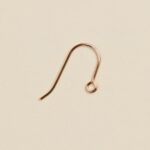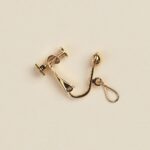The cords used are called mizuhiki, an ancient Japanese craft where tightly wound rice paper is starched for stiffness, colored, and then tied into elaborate forms or designs. Traditionally worn in the hair of samurai and also used to decorate gifts.
Bangles range on average from about 6.5 – 7 cm in diameter.
They are fixed, (do not open), so to wear your bangle simply slip your hand through.
The bangle’s material is strong and flexible so it’s safe to push or pull your hand through slightly as long as it is comfortable to you. Slight force will not damage the bangle.
Please note the appropriate scarf sizes listed for proper pairing. These sizes hold the scarf ring securely in place while wearing it on your body or while wrapping it with a scarf around your bag handle.
If you plan to wear this scarf ring with another scarf you already own, note the sizes listed on this page as a general reference.
To secure your scarf ring, simply weave the scarf through the openings then while holding the outside of the ring with the tips of your fingers see if the ring shifts back and forth easily. If it seems loose, pull more fabric through until it no longer shifts.
Hand-printed in the Hokuriku Region of Japan, our jewelry and objects are adorned with an ancient technique that has over a thousand years of history. Kin-maki-e describes gold and metallic powders that are dusted onto lacquerware and polished repeatedly to create a motif that reflects with fierce radiance.
While historically applied to lacquerware, the base material of our kin-maki-e design patterns used in our collections is a 100% recyclable, waterproof, tree-free synthetic sheet that holds vivid light. Durable yet featherlight, this material is utilized in our home goods and bag collections, as well as inspiring our jewelry collection’s name, “Breath.”
Each and every style and shape is cut into a random design pattern that is printed double-sided, turning each piece into a unique design statement.
Our necklace chain is gold plated brass, 45 cm in length and is adjustable.
Select either pierced or non-pierced earrings style:
 |  |
Pierced 14K Gold-filled | Non-pierced Gold-plated metal |
Our unique ring design is completely adjustable and fits to your finger size.
Claude x Nishiyama Silk Scarves are created in the Ushikubi Tsumugi tradition, a weaving technique from Hakusan, Ishikawa Prefecture, Japan.
A “pongee” silk named an Intangible Cultural Heritage by the Prefecture, Nishiyama Silk is one of the only remaining mills to maintain its 800-year legacy. Our scarves are created with the same process used for weaving kimonos. It’s laborious work, but one that maintains historical care and quality that its legacy demands.
Now on Claude’s YouTube channel find our video series highlighting ways to wear our silk scarves –– and be sure to subscribe to our channel for updates.
Visit here for simple and inspired ideas to try yourself.
Obi-jime (braided kimono belts) are one kind of kumihimo made throughout Japan in places such as Mie, Shiga, Tokyo and Kyoto.
Dating back to the Nara Period (710-794), in this craft, strands are braided to create a multitude of patterns. The number of strands can be as little as 3 to over 100, with each belt consisting of up to several hundred fine threads.
The kumihimo industry is on the decline. However, Claude’s efforts to upcycle and incorporate these stunning belts in our designs is with the aim to regenerate interest in the craft so that active factories remain.
The best of Japanese leather crafting, and technological tooling skill is embodied in each of our bags and small leather goods. Holding a piece in your hand to feel a quality and touch unique to Japan with a two-thousand-year leathercraft legacy behind it.
Since 1923, activity and harmony fills the air of our Tokyo collaborator’s “kobo” (factory) with craftspeople ranging from their 20s to their 70s bringing both wisdom and originality to our designs.
Leather is natural material that changes over time. It softens as does the color, and the surface becomes patinated. Sheild your leather goods from extended exposure to light, extreme heat and humidity. If you use leather care products on our goods – avoid the kin-maki-e embellished areas as they may get damaged.
Please note: Due to COVID-19, international shipping from our store in Japan is temporarily disabled. Please sign up for our newsletter for updates as to when international shipping will resume. We apologize for any inconvenience.
Shipping takes about one week for orders inside Japan. Refunds and exchanges are accepted for up to 14 days after the product has been received.
For more information, please see our FAQ on payment, shipping, refunds & exchanges and more.
